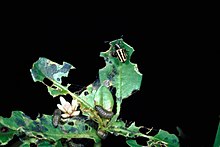| Agasicles hygrophila | |
|---|---|

| |
| Adult and larvae devouring leaves and stems of alligatorweed | |
| Scientific classification | |
| Domain: | Eukaryota |
| Kingdom: | Animalia |
| Phylum: | Arthropoda |
| Class: | Insecta |
| Order: | Coleoptera |
| Infraorder: | Cucujiformia |
| Family: | Chrysomelidae |
| Subfamily: | Galerucinae |
| Tribe: | Alticini |
| Genus: | Agasicles |
| Species: | A. hygrophila
|
| Binomial name | |
| Agasicles hygrophila | |
Agasicles hygrophila is a species of leaf beetle known by the common name alligator weed flea beetle. It has been used successfully as an agent of biological pest control against the noxious aquatic plant known as alligator weed (Alternanthera philoxeroides).
This beetle is native to South America but has been imported to areas where alligator weed is a problem. The adult beetle is 5 mm in length and black with yellow stripes on its elytra. The female lays about 1,000 eggs in her six-week lifetime. Millimeter-long eggs are laid in rows on leaves, and the small yellow larvae emerge and eat the leaves. Adults also feed on the leaves. Defoliation of alligator weed mats kills the weed and clears the infested waterway. This beetle is established in much of the southeastern United States, where it lives on alligator weed only.[2]
The beetle has been used as a biological control of alligator weed in New Zealand.[3]
References[edit]
- ^ Selman, B.J.; Vogt, G.B. (1971). "Lectotype designations in the South American genus Agasicles (Coleoptera: Chrysomelidae), with description of a new species important as a supressant of alligatorweed". Annals of the Entomological Society of America. 64 (5): 1016–1020. doi:10.1093/aesa/64.5.1016.
- ^ Coombs, E.M., ed. (2004). Biological control of invasive plants in the United States. Corvallis: Oregon State University Press. ISBN 978-0870710292.
- ^ Stewart, C.A.; Chapman, R.B.; Frampton, C.M.A. (2000). "Growth of alligator weed (Alternanthera philoxeroides (Mart.) Griseb. (Amaranthaceae)) and population development of Agasicles hygrophila Selman & Vogt (Coleoptera: Chrysomelidae) in northern New Zealand". Plant Protection Quarterly. 15 (3): 95–101. ISSN 0815-2195.
External links[edit]
- Cornell Biological Control Profile
- Smithsonian Report
- TAMU Biocontrol Profile
- alligatorweed flea beetle on the UF / IFAS Featured Creatures Web site